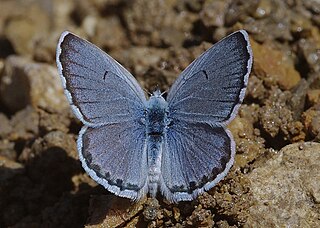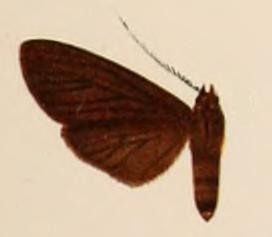
The chalkhill blue is a butterfly in the family Lycaenidae. It is a small butterfly that can be found throughout the Palearctic realm, where it occurs primarily in grasslands rich in chalk. Males have a pale blue colour, while females are dark brown. Both have chequered fringes around their wings.

Per Olof Christopher Aurivillius was a Swedish entomologist.

Pseudophilotes vicrama, the eastern baton blue, is a small butterfly found from Asia, east to Tian Shan and parts of China, west to the Balkans, Turkey, eastern Europe to southern Finland. It belongs to the lycaenids or blues family.
Hans Ferdinand Emil Julius Stichel was a German entomologist who specialised in Lepidoptera.

Hans Fruhstorfer was a German explorer, insect trader and entomologist who specialised in Lepidoptera. He collected and described new species of exotic butterflies, especially in Adalbert Seitz's Macrolepidoptera of the World. He is best known for his work on the butterflies of Java.

The Phaegopterina are a subtribe of tiger moths in the tribe Arctiini, which is part of the family Erebidae. The subtribe was described by William Forsell Kirby in 1892.
Ammalo is a genus of moths in the subtribe Phaegopterina in the family Erebidae. The genus was erected by Francis Walker in 1855.

Zygaena is a genus of moths in the family Zygaenidae. These brightly coloured, day-flying moths are native to the West Palearctic.

Pelochyta is a genus of moths in the family Erebidae. The species was first described by Jacob Hübner in 1819. They are distributed in Africa, throughout India, Myanmar, Sri Lanka, Australia and New Britain.

Leucoblepsis is a genus of moths belonging to the subfamily Drepaninae. The genus was erected by William Warren in 1922.
Max Gaede was a German engineer and entomologist of international fame who described several hundred of new species of Lepidoptera, mainly African Noctuidae.
Louis Beethoven Prout (1864–1943) was an English entomologist and musicologist.
Ammalo ammaloides is a moth of the family Erebidae first described by Walter Rothschild in 1909. It is found in Peru.

Ammalo helops is a moth of the family Erebidae first described by Pieter Cramer in 1775. It is found in Mexico, Guatemala, Costa Rica, Honduras, Panama, Jamaica, Cuba, Haiti, Granada, Trinidad, Amazonas, Brazil, Venezuela, Surinam, Peru and Colombia.
Ammalo peruviana is a moth of the family Erebidae first described by Walter Rothschild in 1922. It is found in Peru.
Ammalo ramsdeni is a moth of the family Erebidae first described by William Schaus in 1924. It is found on Cuba.
Ammalo trujillaria is a moth of the family Erebidae first described by Paul Dognin in 1905. It is found in Peru.
Pelochyta draudti is a moth of the family Erebidae. It was described by Adalbert Seitz in 1922. It is found in Mexico and French Guiana.

Pseudohemihyalea klagesi is a moth in the family Erebidae. It was described by Walter Rothschild in 1909. It is found in Brazil.

Cyclidia is a genus of moths belonging to the subfamily Cyclidiinae. The genus was erected by Achille Guenée in 1857.









